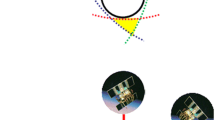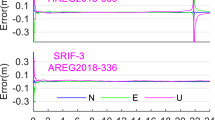Abstract
Precise GPS positioning requires the processing of carrier-phase observations and fixing integer ambiguities. With increasing distance between receivers, ambiguity fixing becomes more difficult because ionospheric and tropospheric effects do not cancel sufficiently in double differencing. A popular procedure in static positioning is to increase the length of the observing session and/or to apply atmospheric (ionospheric) models and corrections. We investigate the methodology for GPS rapid static positioning that requires just a few minutes of dual-frequency GPS observations for medium-length baselines. Ionospheric corrections are not required, but the ionospheric delays are treated as pseudo-observations having a priori values and respective weights. The tropospheric delays are reduced by using well-established troposphere models, and satellite orbital and clock errors are eliminated by using IGS rapid products. Several numerical tests based on actual GPS data are presented. It is shown that the proposed methodology is suitable for rapid static positioning within 50–70 km from the closest reference network station and that centimeter-level precision in positioning is feasible when using just 1 min of dual-frequency GPS data.











Similar content being viewed by others
References
Bartels J (1957) The technique of scaling indices K and Q of geomagnetic activity. Ann Intern Geophys 4(1):215–226
Bosy J, Graszka W, Leończyk M (2007) ASG-EUPOS—a multifunctional precise satellite positioning system in Poland. Eur J Nav 5(4):30–34
Dach R, Hugentobler U, Fridez P, Meindl M (2007) BERNESE GPS Software Version 5.0. Astronomical Institute, University of Berne, Berne, Switzerland, 612 p
de Jong PJ, Bock Y, Bevis M (2000) Epoch-by-epoch™ positioning and navigation. In: Proceedings of ION GPS-2000, The Institute of Navigation, Alexandria, VA, pp 337–342
de Jonge PJ, Tiberius C (1996) The Lambda method for integer ambiguity estimation: implementation aspects. Delft Geodetic Computing Centre LGR Publication 12, Delft, pp 1–49
Euler H-J, Seeger S, Zelzer O, Takac F, Zebhauser BE (2004) Improvement of positioning performance using standardized network RTK messages. In: Proceedings of ION NTM-2004, January 26–28, San Diego, CA, pp 453–461
Gianniou M (1995) Quality analysis of the GPS observations for rapid-static and on-the-fly applications: problems and solutions. J Satell Position Nav Commun (SPN) 20(4):138–146
Goad CC, Goodman L (1974) A modified Hopfield tropospheric refraction correction model. American Geophysical Union Annual Fall Meeting (abstract), San Francisco, CA, December 12–17, pp 28
Grejner-Brzezinska DA, Kashani I, Wielgosz P, Smith DA, Spencer PSJ, Robertson DS, Mader GL (2007) On efficiency and reliability of ambiguity resolution in network-based RTK GPS. J Surv Eng 133(2):56–65
Jakowski N, Mielich J, Borries C, Cander L, Krankowski A, Nava B, Stankov SM (2008) Large-scale ionospheric gradients over Europe observed in October 2003. J Atmos Sol Terr Phys 70(15):1894–1903
Kashani I, Wielgosz P, Grejner-Brzezinska DA, Mader GL (2008) A new network-based rapid-static module for the NGS online positioning user service—OPUS-RS. Navigation 55(3):255–264
Lachapelle G, Erickson C, Bin SB (1991) Precise rapid surveys using a combination of code and carrier measurements. In: Proceedings of ION GPS-1991, September 11–13, Albuquerque, New Mexico, pp 691–698
Lazio P (2007) Constraining network adjustments to OPUS-RS coordinate observations. J Surv Eng 133(3):106–113. doi:10.1061/(ASCE)0733-9453(2007)133:3(106)
Leick A (2004) GPS Satellite Surveying, 3rd edn, John Willey & Sons, Inc. Hoboken, xxiv + 435 p
Odijk D (2000) Weighting ionospheric corrections to improve fast gps positioning over medium distances, In: Proceedings of ION GPS-2000, The Institute of Navigation, Alexandria, pp 1113–1123
Rizos C (2002) Network RTK research and implementation: a geodetic perspective. J GPS 1(2):144–150
Rizos C, Han S, Han X (1998) Performance analysis of a single-frequency, low-cost GPS surveying system. In: Proceedings of ION GPS-1998, September 15–18, Nashville, Tennessee, pp 427–436
Schaffrin B, Bock Y (1988) A unified scheme for processing GPS dual-band phase observations. J Geod 62(2):142–160
Schwarz CR (2008) Heuristic weighting and data conditioning in the National Geodetic Survey rapid static GPS program. J Surv Eng 134(3):76–82. doi:10.1061/(ASCE)0733-9453(2008)134:3(76)
Schwarz CR, Snay RA, Soler T (2009) Accuracy assessment of the National Geodetic Survey’s OPUS-RS utility. GPS Solut 13(2):119–132
Teunissen PJG (1994) A new method for fast carrier phase ambiguity estimation. In: Proceedings of IEEE PLANS, Las Vegas, NV, April 11–15, pp 562–573
Teunissen PJG (1997) The geometry-free GPS ambiguity search space with a weighted ionosphere. J Geod 71(6):370–383
Uotila UA (1986) Notes on adjustment computation, Part I. Department of Geodetic Science and Surveying. The Ohio State University, Columbus, 168 p
Vollath U, Buecherl A, Landau H, Pagels C, Wagner B (2000) Multi-base RTK positioning using virtual reference stations. In: Proceedings of ION GPS-2000, 19–22 September, Salt Lake City, UT, pp 123–131
Wang Z (2003) A new approach to ill-conditioned problems in rapid positioning using single frequency GPS receivers. In: Proceedings of ION GPS/GNSS-2003, September 9–12, Portland, Oregon, 2003, pp 1229–1239
Wang J, Stewart M, Tsakiri M (1998) A discrimination test procedure for ambiguity resolution on-the-fly. J Geod 72(11):644–653. doi:10.1007/s001900050204
Wanninger L (2002) Virtual reference stations for centimeter-level kinematic positioning. In Proceedings of ION GPS-2002, September 24–27, Portland, Oregon, pp 1400–1407
Wielgosz P, Kashani I, Grejner-Brzezinska DA (2005) Analysis of long-range network RTK during severe ionospheric storm. J Geod 79(9):524–531. doi:10.1007/s00190-005-0003-y
Wielgosz P, Krankowski A, Sieradzki R, Grejner-Brzezinska DA (2008) Application of predictive regional ionosphere model to medium range RTK positioning. Acta Geophys 56(4):1147–1161. doi:10.2478/s11600-008-0059-1
Wu J, Yiu FG (1999) Multiple GPS base stations for high-reliability positioning. In: Proceedings of ION 55th AM, June 28–30, Cambridge, MA, pp 333–338
Author information
Authors and Affiliations
Corresponding author
Rights and permissions
About this article
Cite this article
Wielgosz, P. Quality assessment of GPS rapid static positioning with weighted ionospheric parameters in generalized least squares. GPS Solut 15, 89–99 (2011). https://doi.org/10.1007/s10291-010-0168-6
Received:
Accepted:
Published:
Issue Date:
DOI: https://doi.org/10.1007/s10291-010-0168-6




